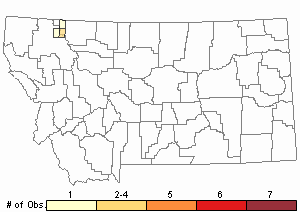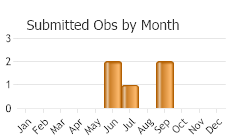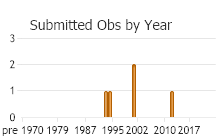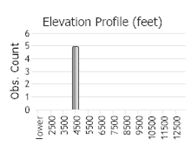View in other NatureServe Network Field Guides
NatureServe
Montana
Utah
Wyoming
Idaho
Wisconsin
British Columbia
South Carolina
Yukon
California
New York
Rocky Mountain Capshell - Acroloxus coloradensis
State Rank Reason (see State Rank above)
Due to this restricted distribution and only a few known occurrences, this species was placed on the MT Species of Concern list as S1, critically imperiled. It is at high risk of extirpation in the state because of very limited and/or potentially declining population numbers, range and/or habitat.
General Description
[From Bryce 1970; Clarke 1970; Harrold and Guralnick 2010] Shell oval, length 1.0-7.0 mm, width 0.6-3.0 mm, height 0.7-1.2 mm; slightly wider anteriorly, very much depressed, light horn color; anterior and posterior shell margins regularly rounded, lateral margins about equally curved, the right somewhat more than the left; anterior, posterior nd right lateral slopes straight, left lateral slope slightly incurved; apex very acute, almost spine-like, eccentric, turned towards the left side, situated at about 2/5 of the length from the posterior margins and about 1/3 of the width from the left margin, radialy striate, the striae continuing over the surface of the shell from the apex to the margins; surface with fine and regular lines of growth and delicately radially striate. The foot and head of moderate width, flecked with gray on a pale purplish-brown background; visceral mass visible through the shell of live individuals as orange to brownish-purple, mantle band dark with a series of small bright blue elongate processes lying across the mantle band and directed to mantle edge, head dusky with two black eyes.
Phenology
Little information. Presumably active throughout the year. Adults produced eggs and egg capsules in captivity in July (Clarke 1970).
Diagnostic Characteristics
[See Clarke 1970, 1981; Paul and Clifford 1991; Harrold and Guralnick 2010; Hossack and Newell 2013 for good descriptions and illustrations.] Limpet-shape, small size, and especially the apex with a spine leaning slightly to the posterior end (instead of with a blunt apex) distinguish this species from all other freshwater limpets in the Rocky Mountains.
Species Range
Montana Range
Range Descriptions

 Native
Native
Range Comments
Isolated lakes (one report from a stream) in British Columbia, Alberta, Ontario, and Quebec in Canada, Colorado and Montana in the US (Bryce 1970; Clarke 1970; Paul and Clifford 1991; Johnson et al. 2013); to at least 2818 m elevation in Colorado (Bryce 1970). In Montana, reported from three lakes and beaver ponds in Glacier National Park, Glacier and Lake counties (Russel and Brunson 1967; Ellis et al. 2004; Hossack and Newell 2013) in the Belly River, Flathead River, and St Mary's River drainages; to about 1433 m elevation.
Observations in Montana Natural Heritage Program Database
Number of Observations: 6
(Click on the following maps and charts to see full sized version)
Map Help and Descriptions
Relative Density

Recency



 (Observations spanning multiple months or years are excluded from time charts)
(Observations spanning multiple months or years are excluded from time charts)
Migration
Sedentary.
Habitat
Habitat is high-altitude lakes and ponds. In Colorado, it is typically found at elevations between 2675 and 3025 m in glacial deposits along at least part of shorelines. Rocky substrates, small drainage basins (< 250 ha), and macrophytic vegetation are often (but not always) associated (Riebesell et al. 2001). Most known populations occur in lakes, but a recent discovery occurred in a very slowly moving portion of Beaver River in Alberta, Canada (Paul and Clifford 1991). In Montana it has been reported in a high mountain lake (Lost Lake) within a small drainage basin (< 250 ha), on cobble-gravel substrate. Densities in Lost Lake, Montana, were highest where flat rocks were piled in layers in relatively shallow water (<1 m) and where the area was not utilized by people for wading and swimming (Ellis et al. 2004). It is an extreme environmental specialist to small alpine lakes only. Macrophytes are generally rare; and this species appears to be a stenothermal lithophile (Paul and Clifford 1991). Its trophic status is primarily a grazer and secondarily a scraper of algae or diatoms (Clarke 1981). In a study of comparative habitat, Riebessell et al. (2001) found lakes with A. coloradensis were significantly lower in elevation (2864 m versus 3074 m) than lakes without the species but higher in elevation than lakes with other snail species. These lakes also had higher calcium content (104 mg per L versus 49 mg per L) and higher conductivity (39 µ cm versus 24 µ per cm) than lakes without A. coloradensis. This indicates the species may be limited to lakes in an elevation band low enough to have enough calcium and other ions but high enough to have rocky substrate that is not too muddy (as is common in highly productive lakes and lakes with large amounts of runoff, as seen commonly at lower elevations).
Reproductive Characteristics
Hermaphroditic, with cross-fertilization. Likely to have a life span up to 2 years. Eggs laid in yellowish masses of 2-3 oval eggs within an egg capsule (about 3.5 X 3.0 mm in size) on submerged rocks, plant stems, leaves (Clarke 1970; Harrold and Guralnick 2010; Johnson et al. 2013).
Management
Acroloxus coloradensis is only known in a very few, extremely small, isolated populations coupled with confined alpine lentic habitat. It is an extreme environmental specialist in small alpine lakes only and dispersal of this species is unlikely. It has no USFWS status at the present time, although it is currently a US Forest Service Species of Concern (SOI) G3 and listed S1 in Montana. These rankings were largely due to the lack of localities reported. Enough survey work has probably been done in CO and MT to demonstrate that this is a rare species, with declining numbers and populations.
Threats or Limiting Factors
Specific threats to populations are habitat loss and degradation coupled with a lack of dispersal mechanisms to colonize other lakes. High recreational usage of lakes may have an impact.
References
- Literature Cited AboveLegend:
 View Online Publication
View Online Publication Bryce, G. W. 1970. Rediscovery of the Limpet, Acroloxus Coloradensis (Basommatophora: Acroloxidae), in Colorado. Nautilus 83(3):105-108.
Bryce, G. W. 1970. Rediscovery of the Limpet, Acroloxus Coloradensis (Basommatophora: Acroloxidae), in Colorado. Nautilus 83(3):105-108. Clarke, A. H. 1970. On Acroloxus Coloradensis Gastropoda Basommatophora in Eastern Canada. Publications in Zoology 2:1-13.
Clarke, A. H. 1970. On Acroloxus Coloradensis Gastropoda Basommatophora in Eastern Canada. Publications in Zoology 2:1-13. Clarke, A.H. 1981. The freshwater molluscs of Canada. National Museum of Natural Sciences, National Museums of Canada, Ottawa. 446 pp.
Clarke, A.H. 1981. The freshwater molluscs of Canada. National Museum of Natural Sciences, National Museums of Canada, Ottawa. 446 pp. Ellis, B.K., L. Marnell, M.A. Anderson, J.A. Stanford, C. Albrecht, and T. Wilke. 2004. Status and ecology of a glacial relict mollusk, the Rocky Mountain capshell limpet (Acroloxus coloradensis), in relation to the limnology of Lost Lake, Glacier National Park, Montana (USA). Open File Report 186-05. Prepared for National Park Service, Glacier National Park, West Glacier, Montana by Flathead Lake Biological Station, The University of Montana, Polson, Montana. 63 pp.
Ellis, B.K., L. Marnell, M.A. Anderson, J.A. Stanford, C. Albrecht, and T. Wilke. 2004. Status and ecology of a glacial relict mollusk, the Rocky Mountain capshell limpet (Acroloxus coloradensis), in relation to the limnology of Lost Lake, Glacier National Park, Montana (USA). Open File Report 186-05. Prepared for National Park Service, Glacier National Park, West Glacier, Montana by Flathead Lake Biological Station, The University of Montana, Polson, Montana. 63 pp. Harrold, M.N. and R.P. Guralnick. 2010. A field guide to the freshwater mollusks of Colorado, second edition. Denver, CO: Colorado Division of Wildlife. 132 p.
Harrold, M.N. and R.P. Guralnick. 2010. A field guide to the freshwater mollusks of Colorado, second edition. Denver, CO: Colorado Division of Wildlife. 132 p. Hossack, Blake and Robert Newell. 2013. New distribution record for the rare limpet Acroloxus coloradensis (Henderson 1930) (Gastropoda: Acroloxidae) from Montana. Research Note. Nautilus 127(1):40-41.
Hossack, Blake and Robert Newell. 2013. New distribution record for the rare limpet Acroloxus coloradensis (Henderson 1930) (Gastropoda: Acroloxidae) from Montana. Research Note. Nautilus 127(1):40-41. Johnson, P.D., A.E. Bogan, K.M. Brown, N.M. Burkhead, J.R. Cordeiro, J.T. Garner, P.D. Hartfield, D.A.W. Lepitzki, G.L. Mackie, E. Pip, T.A. Tarpley, J.S. Tiemann, N.V. Whelan, and E.E. Strong. 2013. Conservation status of freshwater gastropods of Canada and the United States. Fisheries 38:247-282.
Johnson, P.D., A.E. Bogan, K.M. Brown, N.M. Burkhead, J.R. Cordeiro, J.T. Garner, P.D. Hartfield, D.A.W. Lepitzki, G.L. Mackie, E. Pip, T.A. Tarpley, J.S. Tiemann, N.V. Whelan, and E.E. Strong. 2013. Conservation status of freshwater gastropods of Canada and the United States. Fisheries 38:247-282. Paul, A. J. and H. F. Clifford. 1991. Acroloxus coloradensis (Henderson) a rare North American freshwater limpet. Nautilus 105(4):173-174.
Paul, A. J. and H. F. Clifford. 1991. Acroloxus coloradensis (Henderson) a rare North American freshwater limpet. Nautilus 105(4):173-174. Riebesell, J.F., T.L. Thrasher, A. Bazzi, and W.P. Kovalak. 2001. Habitat characteristics of Rocky Mountain (Colorado) populations of Acroloxus coloradensis. American Malacological Bulletin 16(1/2): 33-40.
Riebesell, J.F., T.L. Thrasher, A. Bazzi, and W.P. Kovalak. 2001. Habitat characteristics of Rocky Mountain (Colorado) populations of Acroloxus coloradensis. American Malacological Bulletin 16(1/2): 33-40. Russell, R.H. and R.B. Brunson. 1967. Acroloxus coloradensis from Montana. Nautilus 81(1):33.
Russell, R.H. and R.B. Brunson. 1967. Acroloxus coloradensis from Montana. Nautilus 81(1):33.
- Web Search Engines for Articles on "Rocky Mountain Capshell"
- Additional Sources of Information Related to "Snails / Slugs"





